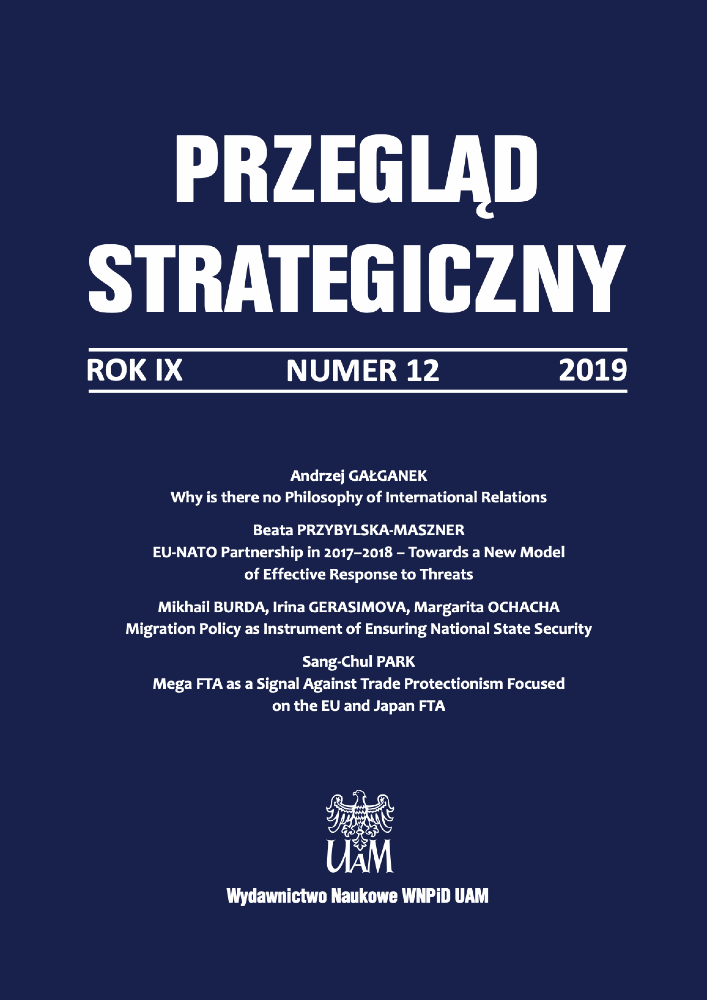Abstrakt
Upadek porządku zimnowojennego w Europie spowodował radykalną zmianę w globalnym systemie bezpieczeństwa. Rozpad Związku Radzieckiego i likwidacja Układu Warszawskiego doprowadziły do sytuacji, w której jedynym poważnym i efektywnym gwarantem stabilności Europy stało się NATO. Państwa Europy Środkowej, które dotąd podporządkowane były ZSRR jednoznacznie i konsekwentnie wybrały euroatlantycki kierunek w polityce bezpieczeństwa. Efektem tego stało się ich pełne, choć stopniowe członkostwo w Sojuszu w latach 1999–2004. Pionierami w tym względzie były Czechy, Węgry i Polska. Europa Środkowa nie jest wolna od zagrożeń związanych z przemianami na poziomie narodowym lub ponadnarodowym. Odrodzenie się mocarstwowych ambicji w Rosji rządzonej przez Władimira Putnia, eskalacja zagrożeń terrorystycznych bądź zagrożenia w cyberprzestrzeni wymagają od NATO większej aktywności i systematycznego potwierdzania solidarnej współpracy i gwarancji bezpieczeństwa wobec wszystkich członków. Kluczowe znaczenie w tym względzie mają decyzje i praktyczne działania związane z cyklicznymi Szczytami NATO. Prezentowany tekst podejmuje analizę bezpieczeństwa Europy Środkowej w ramach NATO w świetle trzech ostatnich szczytów: 2014 w Newport, 2016 w Warszawie i 2018 w Brukseli.
Bibliografia
Belkin P. (2016), NATO’s Warsaw Summit: In Brief, Washington.
Bell R. (2018), The Challenges of NATO Nuclear Policy, FIIA Working Paper, October.
Blum J., Potrafke N. (2019), Does a Change of Government Influence Compliance with International Agreements? Empirical Evidence for the NATO Two Percent Target, Defence and Peace Economics.
Broke-Holland L., Mills C. (2014), NATO Wales Summit 2014: Outcomes, London.
Deni J. R. (2014), NATO’s New Trajectories after the Wales Summit, Parameters, No. 44.
Durkalec J. (2018), The 2018 U.S. Nuclear Posture Review, NATO’s Brussels Summit and Beyond, Livermore.
Flockhart T. (2015), Preparing for NATO’s Warsaw Summit. The Challenges of Adapting to Strategic Change, Copenhagen.
Franke U. (2018), Roundtable Feature: Now What? Lessons for Europe from the NATO Summit, “Texas National Security Review”, Vol. 1, Issue 4, pp. 137–139.
Friis K. (2017), NATO and the Collective Defence in the 21th Century. An Assessment of the Warsaw Summit, London.
Fryc M. (2016), From Wales to Warsaw and Beyond: NATO’s Strategic Adaptation to the Russian Resurgence on Europe’s Eastern Flank, “Connetions: The Quortelly Journal”, No. 4, pp. 45–65.
Giegerich B. (2016), NATO’s Strategic Adaptation, the Warsaw Summit and Beyond, “The Polish Quarterly of International Affairs”, Issue 1, pp. 61–68.
Gizicki W. (2013), A Security Community. Poland and Her Visegrad Allies: the Czech Republic, Hungary and Slovakia, Lublin.
Glatz R. L., Zapfe M. (2016), NATO Defence Planning between Wales and Warsaw, Berlin.
Herzog S. (2010), Western Values and Strategic Interest? Evaluating Potential Georgian Membership in NATO, “Central European Journal of International and Security Studies”, Vol. 4, No. 1, pp. 123–139.
Howorth J. (2017), EU–NATO cooperation: the key to Europe’s security future, “European Security”, Vol. 26, Issue 3, pp. 454–459.
Ivančík R., Nečas P. (2017), Towards Enhanced Security: Defense Expenditures in the Member States of the European Union, “Journal of Security and Sustainability Issues”, Vol. 6, No. 3, pp. 373–382.
Kammel A. H., Zyla B. (eds.) (2018), Peacebuilding at Home. NATO and its ‘New’ Member States after Crimea, Baden-Baden.
Keil S., Oliver T. (2016), What Would a US Policy of “restraint” mean of the Warsaw NATO Summit, “International Politics Reviews”, Vol. 4, Issue 1, pp. 31–35.
Koziej S., Pietrzak P. (2014), NATO Summit in Newport, “Bezieczeństwo Narodowe”, No. 31, pp. 11–29.
Křĭž Z., Fridrichová K. (2015), Libya and Criteria for Humanitarian Intervention, “Czech Journal of Political Science”, No. 3, pp. 183–199.
Larsen J. A. (2016), Time to Face Reality: Priorities for NATO’s 2016 Warsaw Summit, Research Paper, NATO Defence College, No. 126.
Lasconjarias G. (2014), NATO’s Posture after the Wales Summit, IAI Working Papers, No. 14.
Lesser I. (2016), The NATO Warsaw Summit: Reflections on Unfinished Business, The International Spectator, “Italian Journal of International Relations”, Vol. 51, Issue 4, pp. 131–133.
Mattelaer A. (2016), The NATO Warsaw Summit: How to Strengthen Alliance Cohesion, “Strategic Forum”, No. 296.
Nünlist Ch., Zapfe M. (2014), NATO after Wales: Dealing with Russia – Next Steps, Zürich.
Smith M. A., Timmins G. (eds.) (2018), Building a Bigger Europe: EU and NATO Enlargement in Comparative Perspective, London.
Suer T. (2016), Just Leave It: NATO’s Nuclear Weapons Policy at the Warsaw Summit, “Arms Control Today”, Vol. 45, No. 5, pp. 16–21.
Sydoruk T., Tyshchenko D. (2018), Central Europe on Russia-Ukraine Conflict. Positions and Responses, “Central European Journal of International and Security Studies”, Vol. 12, Issue 3, pp. 81–105.
Terlikowski M. (2018) Newport – Warsaw – Brussels: NATO in Defence of Peace in Europe, Warsaw.
Upadhyay D. K. (2016), NATO Warsaw Summit: Outcomes and Implications, ISSUE Brief, 2 August.
Wolff A. T. (2015), The future of NATO enlargement after the Ukraine crisis, “International Affairs”, Vol. 91, Issue 5, pp. 1103–1121.

